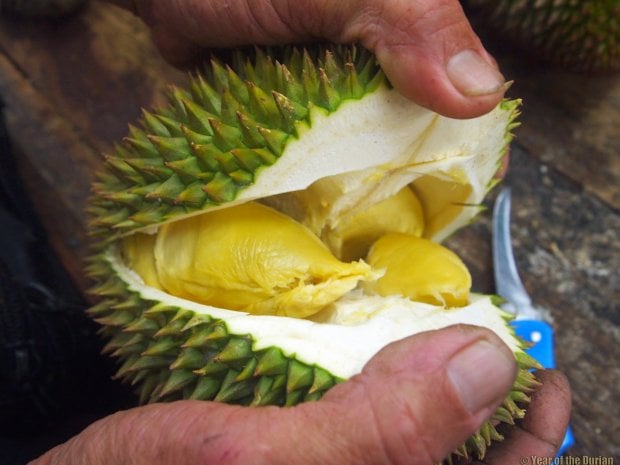
“It must be nice to be privately wealthy,” said the Australian woman on the other end of the phone.
I was calling to interview her about her durian farm, and had just explained that Rob and I really did spend a year in Asia travelling to eat and explore durian.
Her comment made me pause. Was she serious?
I hope not, because that would be a really limiting world perspective. It’s true that travelling to eating durians can be an expensive hobby, but it doesn’t have to be. And you certainly don’t have to be rich (by first world standards) to travel in Southeast Asia.
So here’s our tips and tricks to travelling the world on the hunt for good durians, no matter your budget.
Travelling for cheap is not really rocket science. Well, it can be. Fully utilising credit card bonuses and frequent flier miles still confuses me.
In general, travelling with a small budget is about prioritising and giving up some small material or creature comforts in the name of your larger goal, which in our case is adventure and durian.
There are loads of ways to cut corners or stretch your dimes and dongs (best currency ever). And there are a lot of alternative ways to travel that you may not have considered, like Couchsurfing, Wwoofing, hitching a ride on a sailboat, or working along the way.
But durian expenses are real too, especially if you plan on making your dream vacation one long durian smorgasbord. Durian is one the most coveted and appreciated of fruits, with connoisseurs shelling out dozens of dollars for just a taste.
So here are our top 10 tips for making your money convert into the maximum amount of durian possible without breaking the bank.
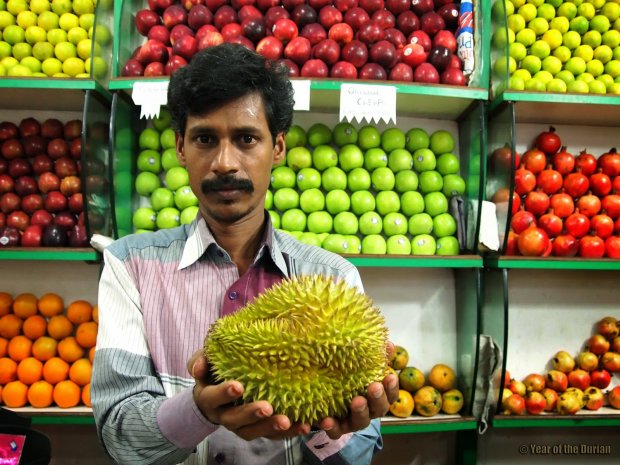
1. Choose your destination based on durian prices
Everybody knows Southeast Asia is cheap. And it makes sense that some countries are cheaper than others – for example, a hotel room in Cambodia is going to be a lot cheaper than even a dorm bed in Singapore (Think USD5 per room vs. USD22 a bed!)
But did you ever consider that durian is more expensive in some countries than in others? If you’re travelling on a budget with the purpose of eating loads of durian, this is something you should consider. And just where you should go (and not go) might come as a surprise.
Most expensive:
- Australia: 12 AUS per kg (~USD11.12)
- Singapore: 12 SGD per kg (~USD9.60)
- India: 700 rupees/kg (~USD11.40)
Mid range durian:
- Vietnam: 50,000 dong per kg (~USD2.36)
- Cambodia: $3 USD per kg (They use the USD)
- Sri Lanka: 400 Rupees per fruit (~USD3.10 per 1.0-1.5 kg fruit, or about USD2.10 per kg)
- Myanmar: 4,000 kyat per fruit (~USD4.11 per fruit, or about USD2.74 per kg)
Cheapest durian:
- Philippines: $1 per kg (~USD1.14)
- Indonesia: 30,000 IDR per fruit (~USD2.54 per 1.5-2kg fruit, or USD1.69 per kg)
- Thailand: 60 baht per kg, (~USD1.80)
2. Travel during durian season
When planning your vacation, remember this quote from Mr. Chang, the Yoda-like durian grower in Penang: “The Durian does not wait for you. You must wait for the durian.”
Durians are gonna drop whenever they’re ready, and you have to make the effort to get yourself to the right place at the right time.
Luckily, durians are dropping somewhere 365 days of the year. All you need to do is figure out where the durian season and your availability coincide, which you can easily do so by getting a free download of our Traveler’s Guide to Durian Season.
There are a lot of reasons why travelling to eat durians during the season is a lot cheaper than looking for durians in the off-season. One is the price of the durian. Durians sold during the scarcity of the off-season can be 3 or 4 times the price of durians sold during the glut of peak season, when durians are sometimes literally given away. (Yes! Free durians!)
For example, a Monthong durian in Bangkok goes from being valued at a $1.87 per kg or less during the peak season, to over $6.25 per kg during the off-season. At that price, a single meal of durian would cost you as much as the price of your hotel room!
Because your hotel room is probably on discount too. Durian season tends to coincide with the off-season for tourists, meaning you also get cheaper hotel rates, empty beaches, locals who are more relaxed, and fewer crowds. It will be the beginning of the rainy season, but what’s more important, a few hours of monsoonal downpour, or some world class, budget-priced durian? Just remember to bring an umbrella.
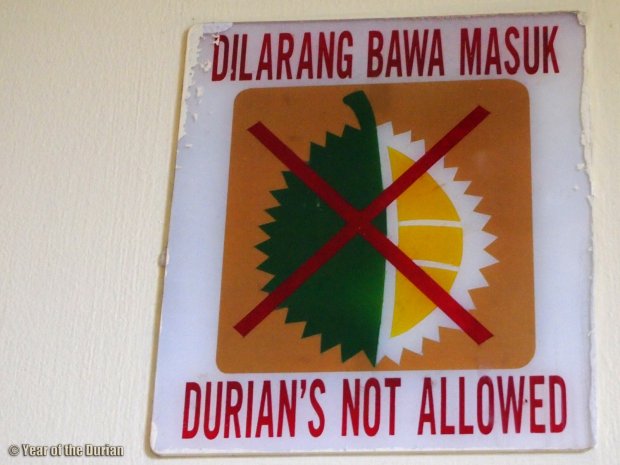
3. Stay at hotels that permit durian
It’s actually a myth that all hotels in Asia ban durian. Actually, mostly the upscale ones or the ones frequented by tourists have those big signs on the walls with the red X through a durian.
A lot of the small, budget hotels actually don’t care if you bring durians into your room or not. Sometimes they just want a piece.
And that’s a double bonus, because it means you can take all the money you’re saving on your cheap accommodations and spend it on more durians AND you can keep your durian hoard wherever you feel like (some hotels will request you store durians in the office).
Sometimes it means forgoing Wifi, or a toilet you can sit on, or televisions that play anything in English. But that’s part of why you’re travelling right? To get a cultural experience in addition to pounding your face with durians. By staying at budget hotels, you can have both.
4. Buy cheaper varieties
There are many, many different types of durian. And they are not all valued alike. Like beer, wine, chocolate, coffee, or anything for that matter, there are cheap types of durian and expensive types of durian.
Cheap durians can often be picked up for $1 a pop, while the most expensive durians are $700 prizes reserved by the social snobbery. If you’re on a tight budget, you’ll want to mostly buy the shwag.
Which doesn’t necessarily taste any worse more expensive durians – they just don’t come with a fancy name or quality control. So you’ll need to work a little harder to judge the durians yourself in order to find a good one.
Here are some durians to look for or avoid for the sake of your budget:
Expensive durian types:
- Musang King (Malaysia)
- Red Prawn (Malaysia)
- Black Thorn (Malaysia)
- Ganyao (Thailand)
- R6 (Vietnam)
- Othong (Indonesia)
Cheap durian types:
- Kampung (Malaysia)
- Ban (Thailand)
- Native (Philippines)
- Chanee (Thailand)
- D24 (Malaysia)
- D99 or Kob (Philippines, Thailand or Malaysia)
Note that each durian comes into season at a different time, and prices may vary depending what’s in abundance. Stick with what’s in season for lowest prices.
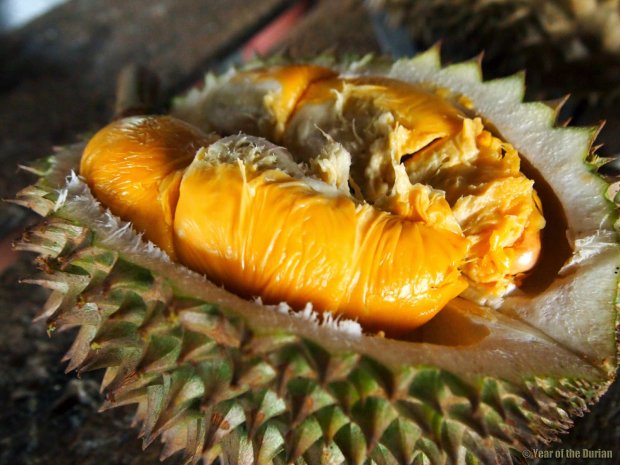
5. Don’t drink alcohol
Speaking of beers and wines, forget about them if you’re on a serious durian hunt.
A lot of tourists spend a miniature fortune on alcohol. Except in Thailand, alcohol is not cheap here, especially in countries like Malaysia or Indonesia that have strong religious prejudices against intoxication.
The $3.50 to buy a beer in Sri Lanka or Malaysia could be used to buy an entire durian. Which would you rather have?
And once you’re eating durian, you probably shouldn’t drink alcohol anyway. Combining alcohol and durian is not that awesome for your health (or your hangover.)
6. Walk to your durian stall
You need to burn off the durian calories anyway, so skip the tuk-tuk or cab and go for a walk.
Walking is our favourite way to explore a new city. You learn all the ins and outs of the streets, get the excuse to talk with friendly locals when you get lost, and get a vibrant and up close look at country you’ve travelled many miles to see.
There’s really no downside to walking to the durian stall. You avoid the stress of haggling for a ride, save a few bucks to spend on durians, and give yourself a happy, healthy appetite.
Some people like Durianrider also enjoy travelling with a bicycle, skipping the mess of public transportation altogether.
7. Don’t be afraid to haggle
Haggling is a way of life in many countries in Asia. Whether it’s over a tuk-tuk ride, a pair of pants, or a durian, many vendors actually expect you to make an offer countering the price they just made up for you. If you don’t, that’s cool for them.
Many people find haggling intimidating, or frustrating at first. Just remember – you’re just asking. Come up with a price that sounds reasonable and fair for what you’re buying, either based on things you’ve already bought or what you see people around you paying. Suggest that price to the vendor. If they give a firm no, that’s that. But chances are they’ll give you a counter offer, and then the haggling can begin.
If you don’t haggle, you’re going to get ripped off. Over and over and over again. If you’re on a tight budget, this means lots of precious dollars leaving your pocket that could have been used on hotel rooms, bus rides, and more durians.
Haggling is a really important skill. Especially when it comes to durians.
8. Learn how to pick out a good durian
Paying too much for a durian is just frustrating. It especially sucks though if you’re wasting your money on crappy durians too.
It’s going to happen at some point, so just accept it already. We’ve been sold bad durians at bad prices so many times I’ve lost count. Sometimes you’re just too tired, or disoriented, or too hungry to really pay attention. But minimising how often it happens can have a big effect on your bank account, the fullness of your belly, and general moral.
The best way to avoid being ripped off is to educate yourself. Learn how to pick out a good durian, so that when a vendor offers you a durian you can decide for yourself if it’s good or bad. Sometimes, just showing that knowledge will inspire the vendor to haul out his good stuff, hidden under canvas or behind a pile. If a vendor offers too many bad durians, sometimes the best option is to walk away and buy from someone more honest.
Bottom line: Don’t waste your money on disappointing or inedible durians.
9. Avoid buying durian in upscale or touristy areas
Even within one city prices for durians can vary a lot. For example, Musang Kings purchased on the trendy Jalan Alor in Kuala Lumpur cost twice the wholesale price. A D24 purchased in touristy Chinatown might be 30% more expensive.
Many upscale or tourist-friendly places won’t even sell the cheaper types of durian (see Tip #5), instead stocking the most popular or well known varieties with higher prices. It’s the same situation in most Supermarkets, where selection is poor and prices high.
To get the best selection and prices, head to large local wet markets that cater to locals and smaller vendors, or areas that specialise in selling durians, like Kalibata in Jakarta or Petaling Jaya in Kuala Lumpur.
Sometimes these only operate in the early morning, or late in the evening, so get familiar with the daily schedule.
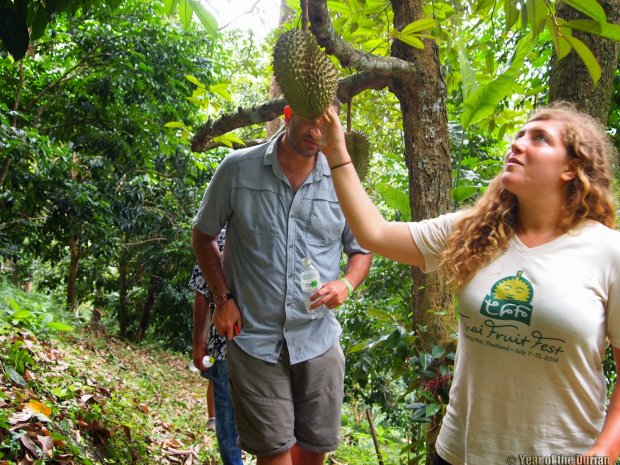
10. Buy direct from growers
If you really want cheap durians, buy direct from the farmer. Not only will the durian be so fresh it tastes incredible, you avoid paying the costs of transport and multiple middlemen.
Some farms even offer homestays, which are also a budget alternative to a hotel. At the homestay, you get to hang out with the grower and see how he cares for his trees. Sometimes you can participate in the harvest. It’s a great way to get a really in depth experience of a different culture while at the same time enjoying the very best durians at the very best prices.
If you’re destination is Thailand, our new book The Durian Tourist’s Guide To Thailand, is designed to help you connect with growers in Thailand so you can have the best durian adventure ever. Otherwise feel free to contact us for suggestions!
Also read: 21 Bizarre Asian Delicacies That You Either Love or Hate
I’m sure there are more ways to get good quality durian without breaking the bank.
If you have some experience or a piece of advice, please share it in the comments below!
Contributed by Year of the Durian.





